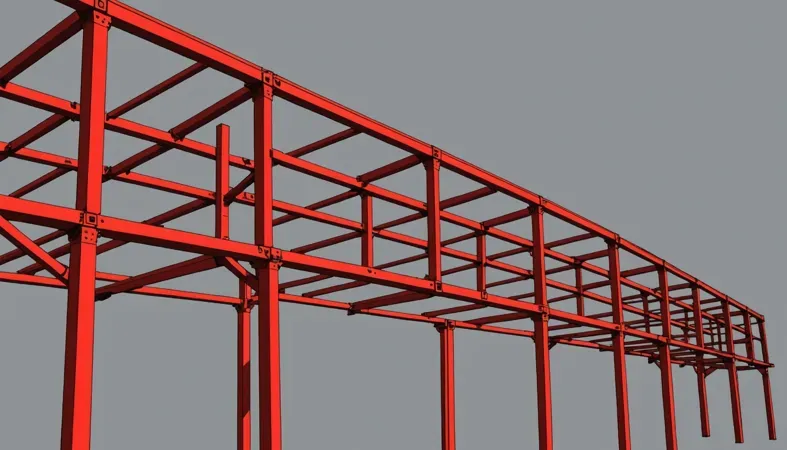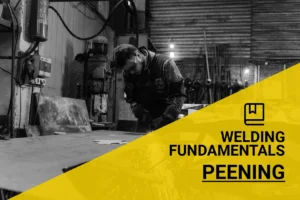How to Weld Edge Joint? Learn About Edge Joint Types, Steps, and Factors!
Published on: April 27, 2025 | Last modified: March 4, 2025
By: Joe Carter
An edge joint is a type of weld where two pieces of metal connect at their edges. This joint provides strength and stability to your structure.
And how to weld edge joint? This process is crucial for a secure build. I’ve learned through experience that meticulously following guidelines can prevent costly mistakes, ensuring your welds hold firm under stress.
In this article, we’ll cover what an edge joint in welding is, the different types of edge joints, steps to weld them, factors that affect edge joint welding, and frequently asked questions. You’ll also get insights into what is edge preparation in welding and what is joint efficiency in welding. This will give you a comprehensive understanding of successful edge joint welding.
Contents
How to Weld Edge Joint?
An edge joint connects two metal pieces along their edges. To weld it, prepare edges at 45 degrees, use 1/8 in (3.2 Mm) filler, and travel at 10 inches (25.4 Cm) per minute. It’s moderate in difficulty; commonly used in sheet metal work. Discover the proper techniques for welding edge joints effectively in various metal projects.
What is an Edge Joint?
An edge joint is a welding connection that joins two pieces of metal along their edges. This joint is typically used for sheet metals of varying thicknesses. Joint preparation depends on thickness; for sheets thinner than 6 mm (0.25 Inches), a single bevel edge may suffice. Thicker materials usually require double bevel preparations. Proper edge joint technique ensures good penetration and structural integrity.
Welding edge joints requires precise edge preparation and careful technique. I prepare the edges by grinding them to ensure a snug fit. This setup helps achieve a strong weld and minimizes defects.
I often use edge joints for sheet metal fabrication projects. For example, I needed strong edge welds for a custom enclosure. The depth of penetration is crucial in edge joint welding; inadequate penetration can reduce joint efficiency and lead to future failures. Understanding joint efficiency in welding can enhance the strength of your work.
Types Of Edge Joints in Welding
What are the types of edge joints to consider?
-
Butt Edge Joints
Butt edge joints connect two pieces of material end-to-end. Align the edges tightly together. First, clean them, then set your welder to the right amperage—around 110-160 Amps for steel—and use a stringer or weave technique to deposit the weld metal. Learn the basic steps in how to make a welder to ensure your weld quality.
-
Corner Edge Joints
Corner edge joints allow two pieces to meet at an angle. Position the materials at 90 degrees. Clamp them, then use a MIG welder with a 0.030-inch (0.76 Mm) wire. Start at the corner and weave your pattern to ensure proper heat distribution. Knowing how to set up MIG welder for sheet metal ensures optimal results for your welds.
-
Lap Edge Joints
Lap edge joints overlap two materials. Place one edge over the other. Secure the pieces, then set your TIG welder at 100-150 Amps and maintain a consistent arc length; use a zigzag pattern for good penetration. If you’re interested in how to build a TIG welder, understanding the mechanics behind TIG welding can be beneficial.
-
T-edge Joints
T-edge joints create a T-shape by joining edges at right angles. Fit the materials snugly, then tack weld the joint. Use a stick welder with E6011 rod at 70-90 Amps, ensuring a uniform bead along the structure.
-
Scarf Edge Joints
Scarf edge joints create a slanted fit between two plates. Grind the edges to a bevel, then align them. Use a MIG welder set to 140-180 Amps, moving in a steady motion to avoid burn-through and ensuring a full fill of the bevel. Proper technique is crucial for effective MIG welding of scarf joints.
That covers the various edge joint types in welding. Let’s now take a look at the steps to weld an edge joint.

Steps to Weld Edge Joint
Here are the steps for effectively welding an edge joint. Follow them all for a strong connection.
-
Prepare the Edge Surface
Clean the edges you’ll weld. Remove impurities like rust, paint, and dirt using a wire brush or grinder. A clean surface improves fusion. For best results, aim for a surface roughness of 1.6 µm (63 Μin) or less.
If the edges are thick, bevel them to an angle of 30° to 45°. This creates a better weld pool. A precise bevel reduces the risk of undercutting.
-
Select the Appropriate Electrode
Choosing the right electrode is crucial. Selecting an appropriate welding electrode involves understanding material properties and joint types. For steel edge joints, use E7018 or ER70S-6 electrodes; they provide a strong, ductile weld. A diameter of 2.4 mm (3/32 in) to 3.2 mm (1/8 in) is suitable.
Adjust the electrode diameter based on material thickness. Thicker materials need larger electrodes. Using the correct size significantly improves weld penetration and strength.
-
Set Up the Welding Equipment
Configure the welder for the edge joint. Set the voltage and amperage based on the electrode diameter, typically around 70-80 Amps for 3.2 mm (1/8 in) electrodes. Use direct current (DC) set to reverse polarity for stick welding.
Check the shielding gas settings if using MIG welding. A 75/25 argon-carbon dioxide mix works well. Ensure everything’s grounded to avoid electrical issues, as I learned the hard way!
-
Align the Edge Joints
Align the parts to be welded. Use clamps to secure the edges, ensuring no gap larger than 2 mm (1/16 in). Proper alignment prevents warping and misalignment during welding. Use tack welds strategically to hold everything in place.
Check for squareness with a carpenter’s square. Double-checking is essential; it’s easy to overlook this before welding! Precision means a stronger finished product.
-
Execute the Welding Process
Begin welding. Move at a consistent speed of about 130-150 mm/min (5-6 Inches/min). Keeping the torch angle at 15° to the vertical is essential for good penetration. For those looking to refine their skills, following detailed welding guidance ensures consistency in the bead.
Learning how to run a bead effectively can enhance your welding proficiency.
If you’re doing multiple passes, avoid overheating the weld. Overheating can weaken the joint. Controlling heat input made a significant difference in my weld quality.
That covers the steps to weld an edge joint. Let’s now take a look at the factors affecting edge joint welding.
Factors Affecting Edge Joint Welding
What factors impact your edge joint welding technique and quality?
-
Material Thickness
Thicker materials require more heat and careful technique. For example, welding 1/4 inch (6.35 Mm) steel calls for a different approach than welding 1/8 inch (3.17 Mm) steel.
-
Joint Design
The design of your edge joint matters. A beveled edge joint allows for better penetration and strength than a simple edge joint.
-
Welding Technique
Choose a technique like MIG (Metal Inert Gas) or TIG (Tungsten Inert Gas) based on the joint type. The right technique improves joint efficiency. Edge welds, for example, need consistent heat and motion. MIG welding excels at fusing different metal thicknesses efficiently.
-
Heat Input
Control heat input for optimal welds. Too much heat can cause warping, while too little can result in weak joints. Aim for an average of 10 to 15 volts for most steels.
-
Welding Position
Your position while welding affects the outcome. Flat positions are easier than vertical or overhead. Start as level as possible for quality edge joint welds.
We have now covered factors influencing edge joint welding. Next, we will examine techniques for edge joint welding.
Edge Joint Welding Techniques
Let’s explore some techniques to improve your edge joint welding skills.
-
Backstep Welding
This technique involves moving the arc in the opposite direction of your weld. Backstep welding reduces distortion by controlling heat distribution. It’s great for thicker materials.
-
Weaving Techniques
Weaving helps to spread heat evenly across the joint, especially for wider edges. Use a zigzag pattern for better penetration and to fill gaps effectively.
-
Stringer Bead Technique
This method uses a straight bead without weaving. It’s effective for thin materials and offers cleaner, narrower welds. Ideal for quick, straightforward edge joints.
-
Multi-Pass Welding
For thicker materials, consider multiple passes. Layer your weld bead thoughtfully, allowing for cooling time. Each pass improves penetration and joint strength.
You should now have a good understanding of edge joint welding methods and their applications. In the next part, we’ll discuss the performance comparison of welding techniques.

Performance Comparison of Welding Techniques
| Technique | Material Thickness (mm) | Heat Input (kJ/cm) | Strength (MPa) | Application |
|---|---|---|---|---|
| Backstep Welding | 5-15 | 2-3 | 450-550 | Thicker joints |
| Weaving Techniques | 3-10 | 1-2 | 400-480 | Wider edges |
| Stringer Bead Technique | 1-5 | 0.5-1 | 350-400 | Thin sheets |
| Multi-Pass Welding | 10-20 | 2-4 | 500-600 | Heavy structural joints |
Common Defects in Edge Joint Welding
Understanding defects helps you improve your edge joint welding quality.
| Defect Type | Description | Causes | Solutions |
|---|---|---|---|
| Undercut | A groove melted into the base metal adjacent to the weld bead. | Excessive heat input or incorrect travel speed. | Reduce heat and stabilize your travel speed. |
| Porosity | Gas bubbles trapped in the weld metal. | Moisture, dirty surfaces, or improper shielding gas. | Clean surfaces thoroughly and check gas flow rates. |
| Cracking | Fractures in the weld or base metal. | Rapid cooling or high-stress concentrations. | Control cooling rates and use preheat as necessary. |
| Incomplete Penetration | The weld does not penetrate deeply enough. | Incorrect bevel, travel speed too fast. | Adjust the bevel angle and slow down your travel speed. |
| Lack of Fusion | Where the weld metal doesn’t fuse with the base metal. | Dirty surfaces or insufficient heat. | Ensure clean edges and appropriate heat settings. |
Frequently Asked Questions (FAQs)
Here are some questions I typically get asked about edge joint welding.
What is Edge Joint Welding?
Edge joint welding refers to the method used for joining two edges of metal together. This technique is important for achieving strong connections in applications where thickness and alignment matter, making it vital in the automotive and construction industries.
What is Edge Preparation in Welding?
Edge preparation in welding is the process of shaping the metal edges before welding. Proper edge preparation ensures better fusion and strength. For instance, beveling edges at a 45° angle improves penetration, reducing the risk of defects like undercuts.
What is Joint Efficiency in Welding?
Joint efficiency in welding measures the strength of a welded joint compared to the base material. It typically ranges from 0.60 to 1.00 in steel welds. Higher efficiency indicates better quality and performance, essential for structural integrity and safety.
Which Weld Method Can Be Used for Welding Two Plates Edge to Edge?
The method used for welding two plates edge to edge is commonly the TIG (Tungsten Inert Gas) welding. This method is favored for its precision and ability to produce high-quality welds, especially for thicker materials over 5mm (0.2 Inches). Using TIG welding is ideal for applications requiring top-notch finish quality.
How Do You Prepare a Welding Edge?
Preparing a welding edge involves cleaning the surface and creating a suitable profile. Common techniques include grinding or machining the edges to ensure proper fit-up, reducing contaminants by wiping with a solvent, and making sure there are no irregularities or gaps. Understanding these welding techniques can greatly enhance the quality of the weld.
What Welding Rod to Weld on Cutting Edge?
The best welding rod for a cutting edge typically depends on the type of material. For carbon steel, E7018 rods are common, while, for stainless steel, E308L is preferred. Selecting the right rod ensures durability and performance, optimizing the weld for wear resistance.
Conclusion
Phew, that’s a lot to digest. We covered what an edge joint is, different types of edge joints in welding, steps to weld an edge joint, and factors affecting edge joint welding, along with some frequently asked questions. Understanding these elements will surely help you get the hang of this welding process.
Hopefully, I was able to impart some of my experience on how to weld an edge joint. You need to prepare your edges, select a suitable filler, and know your welding parameters. By focusing on these basics—like joint prep, weld speed, and heat input—you can become skilled at edge joint welding in no time.
If you’re eager to deepen your knowledge and explore additional welding topics, I encourage you to visit What is Welding for all things related to welding.
References
- American Society of Mechanical Engineers. (2019). ASME Section IX: Welding and Brazing Qualifications. New York, NY: ASME.
Joe Carter is a retired welding professional with over 40 years of hands-on experience in the industry, spanning ship repair, structural welding, and even underwater projects. Joe is a master of MIG, TIG, and Stick welding. Passionate about mentoring the next generation of welders, Joe now shares his decades of expertise and practical insights to help others build rewarding careers in welding.
Construction, Edge Joint, Joint Preparation, Metal Fabrication, MIG Welding, Structural Integrity, TIG Welding, Welding, Welding Techniques







